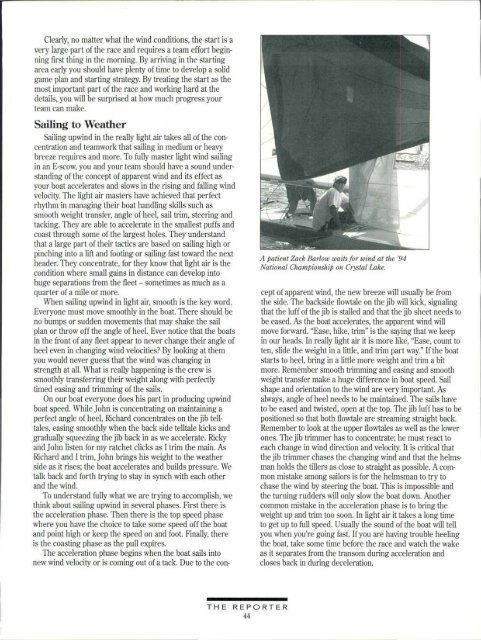You also want an ePaper? Increase the reach of your titles
YUMPU automatically turns print PDFs into web optimized ePapers that Google loves.
Clearly, no matter what the wind conditions, the start is a<br />
very large part of the race and requires a team effort beginning<br />
first thing in the morning. By arriving in the starting<br />
area early you should have plenty of time to develop a solid<br />
game plan and starting strategy. By treating the start as the<br />
most important part of the race and working hard at the<br />
details, you will be surprised at how much progress your<br />
team can make.<br />
Sailing to Weather<br />
Sailing upwind in the really light air takes all of the concentration<br />
and teamwork that sailing in medium or heavy<br />
breeze requires and more. To fully master light wind sailing<br />
in an E-scow, you and your team should have a sound understanding<br />
of the concept of apparent wind and its effect as<br />
your boat accelerates and slows in the rising and falling wind<br />
velocity. The light air masters have achieved that perfect<br />
rhythm in managing their boat handling skills such as<br />
smooth weight transfer, angle of heel, sail trim, steering and<br />
tacking. They are able to accelerate in the smallest puffs and<br />
coast through some of the largest holes. They understand<br />
that a large part of their tactics are based on sailing high or<br />
pinching into a lift and footing or sailing fast toward the next<br />
header. They concentrate, for they know that light air is the<br />
condition where small gains in distance can develop into<br />
huge separations from the Oeet - sometimes as much as a<br />
quarter of a mile or more.<br />
When sailing upwind in light air, smooth is the key word.<br />
Everyone must move smoothly in the boat There should be<br />
no bumps or sudden movements that may shake the sail<br />
plan or throw off the angle of heel. Ever notice that the boats<br />
in the front of any Oeet appear to never change their angle of<br />
heel even in changing wind velocities? By looking at them<br />
you would never guess that the wind was changing in<br />
strength at all. What is really happening is the crew is<br />
smoothly transferring their weight along with perfectly<br />
timed easing and trimming of the sails.<br />
On ow· boat everyone does his part in producing upwind<br />
boat speed. While John is concentrating on maintaining a<br />
perfect angle of heel, Richard concentrates on the jib telltales,<br />
easing smoothly when the back side telltale kicks and<br />
gradually squeezing the jib back in as we accelerate. Ricky<br />
and John listen for my ratchet clicks as I trim the main. As<br />
Richard and I trim, john brings his weight to the weather<br />
side as it rises; the boat accelerates and builds pressure. We<br />
talk back and forth trying to stay in synch with each other<br />
and the wind.<br />
To understand fully what we are trying to accomplish, we<br />
think about sailing upwind in several phases. First there is<br />
the acceleration phase. Then there is the top speed phase<br />
where you have the choice to take some speed off the boat<br />
and point high or keep the speed on and foot Finally, there<br />
is the coasting phase as the pulJ expires.<br />
The acceleration phase begins when the boat sails into<br />
new wind velocity or is coming out of a tack. Due to the con-<br />
T H E R EPORTER<br />
44<br />
A patient Zack Barlow wails/or wind at the '94<br />
National Clzampio11ship 011 Crystal Lake.<br />
cept of apparent wind, the new breeze will usually be from<br />
the side. The backside flowtale on the jib will kick, signaling<br />
that the luff of the jib is stalled and that the jib sheet needs to<br />
be eased. As the boat accelerates, the apparent wind will<br />
move forward. "Ease, hike, trim" is the saying that we keep<br />
in our heads. In really light air it is more like, "Ease, count to<br />
ten, slide the weight in a little, and trim part way." If the boat<br />
starts to heel, bring in a little more weight and trim a bit<br />
more. Remember smooth trimming and easing and smooth<br />
weight transfer make a huge difference in boat speed. Sail<br />
shape and orientation to the wind are very important. As<br />
always, angle of heel needs to be maintained. The sails have<br />
to be eased and twisted, open at the top. The jib luff has to be<br />
positioned so that both flowtale are streaming straight back.<br />
Remember to look at the upper flowtales as well as the lower<br />
ones. The jib trimmer has to concentrate; he must react to<br />
each change in wind direction and velocity. It is clitical that<br />
the jib trimmer chases the changing wind and that the helmsman<br />
holds the ti!Jers as close to straight as possible. A common<br />
mistake among sailors is for the helmsman to try to<br />
chase the wind by steering the boat This is impossible and<br />
the turning rudders wilJ only slow the boat down. Another<br />
common mistake in the acceleration phase is to bring the<br />
weight up and trim too soon. In light air it takes a long time<br />
to get up to full speed. Usually the sound of the boat will tell<br />
you when you're going fast If you are having trouble heeling<br />
the boat, take some time before the race and watch the wake<br />
as it separates from the transom during acceleration and<br />
closes back in during deceleration.


